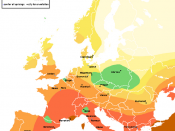"The bubonic plague is an epidemic disease causing a high rate of mortality; a contagious disease that is caused by a bacterium (Yersinia pestis) and that occurs in bubonic, pneumonic and septicemic forms. It is also a cause of irritation, or a sudden unwelcome outbreak." Millions of people and their families have had a close encounter with this Black Death with nothing good to come from it. The nasty disease comes right in and takes over you and everything around you, ending in death. Just imagine if a plague outbreak would happen today and the effects it would have on each and every one of us. By examining the impact of the devastation it had on medieval England, we can see how distressing an attack with plague would be today.
The origin of the bubonic plague is unknown but it may have started in Africa or India.
Many years ago, colonies of infected rats were established in India. Some of these rodents infected traders on the route between the Middle East and China. Traders and Mongol armies transferred it westward from China in the 14th century. In 1346, the disease reached Crimea and found its way to Europe in 1347. The outbreak in Europe was a devastating one, which resulted in more than 25 million deaths, about twenty-five percent of the world's whole population. After that, the plague had a rapid disappearance for which no explanation has ever been given. Still today, there are reoccurrences of the plague in cities all around the world.
The Black Death came in three forms, the bubonic, pneumonic, and septicemic. Each different form of plague killed people in a vicious way. The bubonic plague was the most commonly seen form of the Black Death. "The mortality rate was 30-75%." The symptoms...


